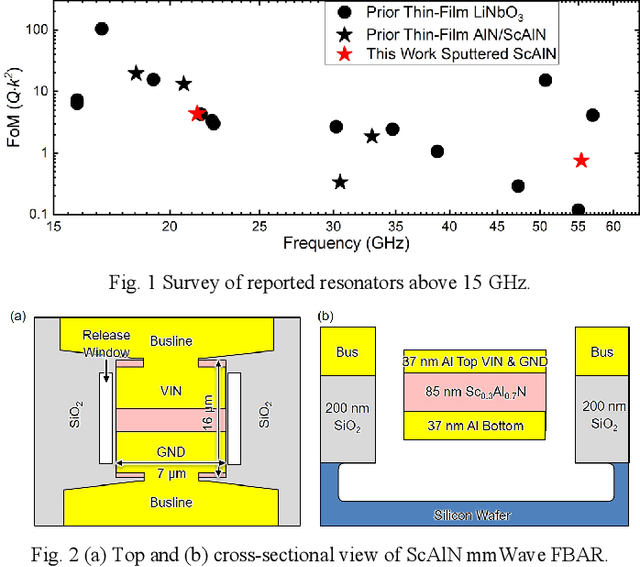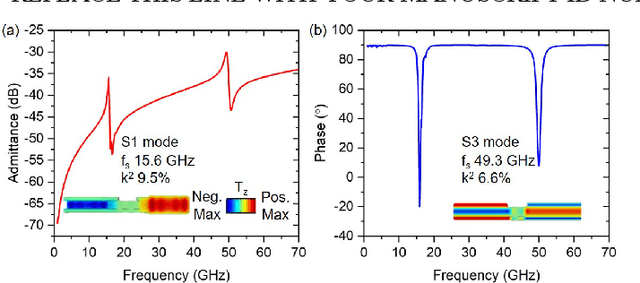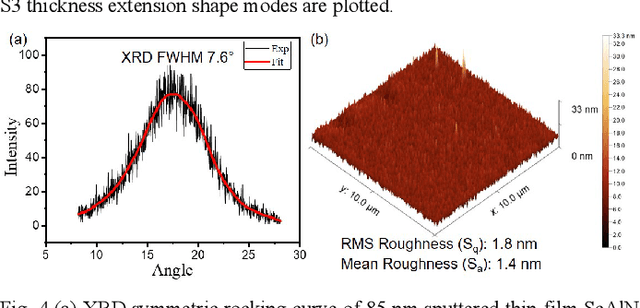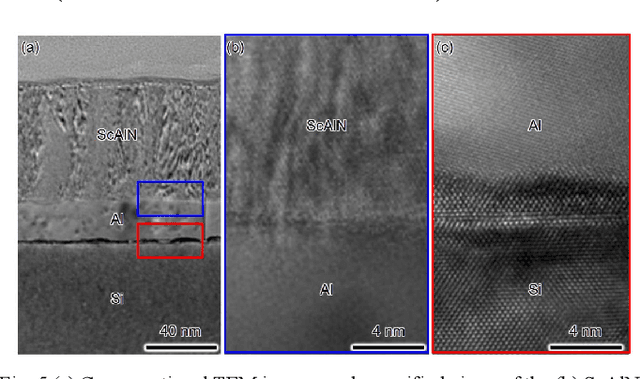Sinwoo Cho
C-Band Lithium Niobate on Silicon Carbide Surface Acoustic Wave Resonator with Figure-of-Merit of 124 at 6.5 GHz
Feb 26, 2024Abstract:In this work, we demonstrate a C-band shear-horizontal surface acoustic wave (SH-SAW) resonator with high electromechanical coupling (keff2) of 22% and a quality factor (Q) of 565 based on a thin-film lithium niobate (LN) on silicon carbide (SiC) platform, featuring an excellent figure-of-merit (FoM = keff2*Q ) of 124 at 6.5 GHz, the highest FoM reported in this frequency range. The resonator frequency upscaling is achieved through wavelength ($\lambda$) reduction and the use of thin aluminum (Al) electrodes. The LN/SiC waveguide and synchronous resonator design collectively enable effective acoustic energy confinement for a high FoM, even when the normalized thickness of LN approaches a scale of 0.5$\lambda$ to 1$\lambda$. To perform a comprehensive study, we also designed and fabricated five additional resonators, expending the $\lambda$ studied ranging from 480 to 800 nm, in the same 500 nm-thick transferred Y-cut thin-film LN on SiC. The fabricated SH-SAW resonators, operating from 5 to 8 GHz, experimentally demonstrate a keff2 from 20.3% to 22.9% and a Q from 350 to 575, thereby covering the entire C-band with excellent performance.
Thin-film Lithium Niobate on Insulator Surface Acoustic Wave Devices for 6G Centimeter Bands
Feb 26, 2024Abstract:In this work, we investigate the frequency scaling of shear-horizontal (S.H.) surface acoustic wave (SAW) resonators based on a lithium niobate on insulator (LNOI) substrate into the centimeter bands for 6G wireless systems. Prototyped resonators with wavelengths ranging between 240 nm and 400 nm were fabricated, and the experimental results exhibit a successful frequency scaling between 9.05 and 13.37 GHz. However, a noticeable performance degradation can be observed as the resonance frequency (fs) scales. Such an effect is expected to be caused by non-ideal helec/{\lambda} for smaller {\lambda} devices. The optimized LNOI SH-SAW with a {\lambda} of 400 nm exhibits a fs of 9.05 GHz, a keff2 of 15%, Qmax of 213 and a FoM of 32, which indicates a successful implementation for device targeting centimeter bands.
23.8 GHz Acoustic Filter in Periodically Poled Piezoelectric Film Lithium Niobate with 1.52 dB IL and 19.4% FBW
Feb 19, 2024Abstract:This paper reports the first piezoelectric acoustic filter in periodically poled piezoelectric film (P3F) lithium niobate (LiNbO3) at 23.8 GHz with low insertion loss (IL) of 1.52 dB and 3-dB fractional bandwidth (FBW) of 19.4%. The filter features a compact footprint of 0.64 mm2. The third-order ladder filter is implemented with electrically coupled resonators in 150 nm bi-layer P3F 128 rotated Y-cut LiNbO3 thin film, operating in second-order symmetric (S2) Lamb mode. The record-breaking performance is enabled by the P3F LiNbO3 platform, where piezoelectric thin films of alternating orientations are transferred subsequently, facilitating efficient higher-order Lamb mode operation with simultaneously high quality factor (Q) and coupling coefficient (k2) at millimeter-wave (mmWave). Also, the multi-layer P3F stack promises smaller footprints and better nonlinearity than single-layer counterparts, thanks to the higher capacitance density and lower thermal resistance. Upon further development, the reported P3F LiNbO3 platform is promising for compact filters at mmWave.
Millimeter Wave Thin-Film Bulk Acoustic Resonator in Sputtered Scandium Aluminum Nitride Using Platinum Electrodes
Nov 22, 2023



Abstract:This work describes sputtered scandium aluminum nitride (ScAlN) thin-film bulk acoustic resonators (FBAR) at millimeter wave (mmWave) with high quality factor (Q) using platinum (Pt) electrodes. FBARs with combinations of Pt and aluminum (Al) electrodes, i.e., Al top Al bottom, Pt top Al bottom, Al top Pt bottom, and Pt top Pt bottom, are built to study the impact of electrodes on mmWave FBARs. The demonstrated FBAR with Pt top and bottom electrodes achieve electromechanical coupling (k2) of 4.0% and Q of 116 for the first-order symmetric (S1) mode at 13.7 GHz, and k2 of 1.8% and Q of 94 for third-order symmetric (S3) mode at 61.6 GHz. Through these results, we confirmed that even in the frequency band of approximately 60 GHz, ScAlN FBAR can achieve a Q factor approaching 100 with optimized fabrication and acoustic/EM design. Further development calls for stacks with better quality in piezoelectric and metallic layers.
Transferred Thin Film Lithium Niobate as Millimeter Wave Acoustic Filter Platforms
Nov 21, 2023Abstract:This paper reports the first high-performance acoustic filters toward millimeter wave (mmWave) bands using transferred single-crystal thin film lithium niobate (LiNbO3). By transferring LiNbO3 on the top of silicon (Si) and sapphire (Al2O3) substrates with an intermediate amorphous Si (aSi) bonding and sacrificial layer, we demonstrate compact acoustic filters with record-breaking performance beyond 20 GHz. In the LN-aSi-Al2O3 platform, the third-order ladder filter exhibits low insertion loss (IL) of 1.62 dB and 3-dB fractional bandwidth (FBW) of 19.8% at 22.1 GHz, while in the LN-aSi-Si platform, the filter shows low IL of 2.38 dB and FBW of 18.2% at 23.5 GHz. Material analysis validates the great crystalline quality of the stacks. The high-resolution x-ray diffraction (HRXRD) shows full width half maximum (FWHM) of 53 arcsec for Al2O3 and 206 arcsec for Si, both remarkably low compared to piezoelectric thin films of similar thickness. The reported results bring the state-of-the-art (SoA) of compact acoustic filters to much higher frequencies, and highlight transferred LiNbO3 as promising platforms for mmWave filters in future wireless front ends.
38.7 GHz Thin Film Lithium Niobate Acoustic Filter
Nov 09, 2023



Abstract:In this work, a 38.7 GHz acoustic wave ladder filter exhibiting insertion loss (IL) of 5.63 dB and 3-dB fractional bandwidth (FBW) of 17.6% is demonstrated, pushing the frequency limits of thin-film piezoelectric acoustic filter technology. The filter achieves operating frequency up to 5G millimeter wave (mmWave) frequency range 2 (FR2) bands, by thinning thin-film LiNbO3 resonators to sub-50 nm thickness. The high electromechanical coupling (k2) and quality factor (Q) of first-order antisymmetric (A1) mode resonators in 128 Y-cut lithium niobate (LiNbO3) collectively enable the first acoustic filters at mmWave. The key design consideration of electromagnetic (EM) resonances in interdigitated transducers (IDT) is addressed and mitigated. These results indicate that thin-film piezoelectric resonators could be pushed to 5G FR2 bands. Further performance enhancement and frequency scaling calls for better resonator technologies and EM-acoustic filter co-design.
Millimeter Wave Thin-Film Bulk Acoustic Resonator in Sputtered Scandium Aluminum Nitride
Sep 06, 2023



Abstract:This work reports a millimeter wave (mmWave) thin-film bulk acoustic resonator (FBAR) in sputtered scandium aluminum nitride (ScAlN). This paper identifies challenges of frequency scaling sputtered ScAlN into mmWave and proposes a stack and new fabrication procedure with a sputtered Sc0.3Al0.7N on Al on Si carrier wafer. The resonator achieves electromechanical coupling (k2) of 7.0% and quality factor (Q) of 62 for the first-order symmetric (S1) mode at 21.4 GHz, along with k2 of 4.0% and Q of 19 for the third-order symmetric (S3) mode at 55.4 GHz, showing higher figures of merit (FoM, k2xQ) than reported AlN/ScAlN-based mmWave acoustic resonators. The ScAlN quality is identified by transmission electron microscopy (TEM) and X-ray diffraction (XRD), identifying the bottlenecks in the existing piezoelectric-metal stack. Further improvement of ScAlN/AlN-based mmWave acoustic resonators calls for better crystalline quality from improved thin-film deposition methods.
Fundamental Antisymmetric Mode Acoustic Resonator in Periodically Poled Piezoelectric Film Lithium Niobate
Aug 27, 2023Abstract:Radio frequency (RF) acoustic resonators have long been used for signal processing and sensing. Devices that integrate acoustic resonators benefit from their slow phase velocity (vp), in the order of 3 to 10 km/s, which allows miniaturization of the device. Regarding the subject of small form factor, acoustic resonators that operate at the so-called fundamental antisymmetric mode (A0), feature even slower vp (1 to 3 km/s), which allows for smaller devices. This work reports the design and fabrication of A0 mode resonators leveraging the advantages of periodically poled piezoelectricity (P3F) lithium niobate, which includes a pair of piezoelectric layers with opposite polarizations to mitigate the charge cancellation arising from opposite stress of A0 in the top and bottom piezoelectric layers. The fabricated device shows a quality factor (Q) of 800 and an electromechanical coupling (k2) of 3.29, resulting in a high figure of merit (FoM, Q times k2) of 26.3 at the resonant frequency of 294 MHz, demonstrating the first efficient A0 device in P3F platforms. The proposed A0 platform could enable miniature signal processing, sensing, and ultrasound transducer applications upon optimization.
Thin-Film Lithium Niobate Acoustic Resonator with High Q of 237 and k2 of 5.1% at 50.74 GHz
Jul 11, 2023Abstract:This work reports a 50.74 GHz lithium niobate (LiNbO3) acoustic resonator with a high quality factor (Q) of 237 and an electromechanical coupling (k2) of 5.17% resulting in a figure of merit (FoM, Q x k2) of 12.2. The LiNbO3 resonator employs a novel bilayer periodically poled piezoelectric film (P3F) 128 Y-cut LiNbO3 on amorphous silicon (a-Si) on sapphire stack to achieve low losses and high coupling at millimeter wave (mm-wave). The device also shows a Q of 159, k2 of 65.06%, and FoM of 103.4 for the 16.99 GHz tone. This result shows promising prospects of P3F LiNbO3 towards mm-wave front-end filters.
Thin-Film Lithium Niobate Acoustic Filter at 23.5 GHz with 2.38 dB IL and 18.2% FBW
Jul 10, 2023Abstract:This work reports an acoustic filter at 23.5 GHz with a low insertion loss (IL) of 2.38 dB and a 3-dB fractional bandwidth (FBW) of 18.2%, significantly surpassing the state-of-the-art. The device leverages electrically coupled acoustic resonators in 100 nm 128{\deg} Y-cut lithium niobate (LiNbO3) piezoelectric thin film, operating in the first-order antisymmetric (A1) mode. A new film stack, namely transferred thin-film LiNbO3 on silicon (Si) substrate with an intermediate amorphous silicon (a-Si) layer, facilitates the record-breaking performance at millimeter-wave (mmWave). The filter features a compact footprint of 0.56 mm2. In this letter, acoustic and EM consideration, along with material characterization with X-ray diffraction and verified with cross-sectional electron microscopy are reported. Upon further development, the reported filter platform can enable various front-end signal-processing functions at mmWave.
 Add to Chrome
Add to Chrome Add to Firefox
Add to Firefox Add to Edge
Add to Edge